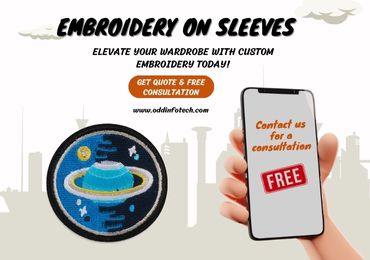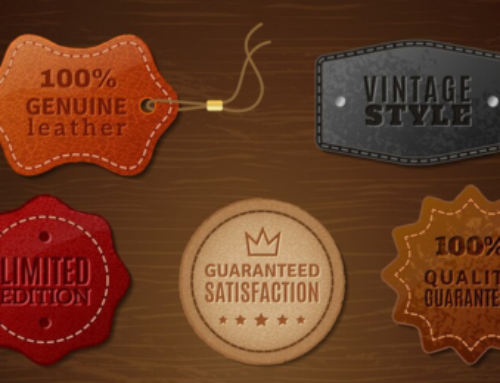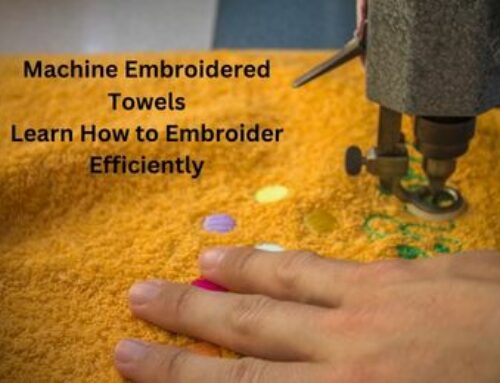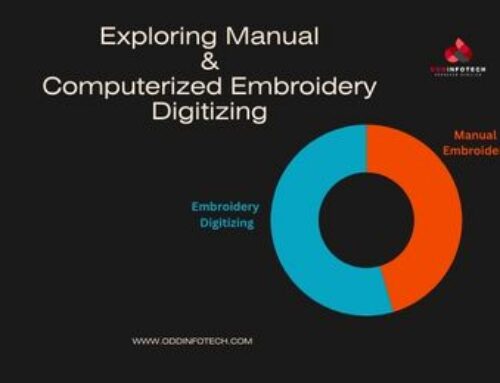Embroidery on sleeves is not merely a trend but a timeless art form that has captivated cultures across centuries. From intricate handcrafted designs to modern digital innovations, sleeve embroidery has evolved into a dynamic expression of individuality and style. In this comprehensive guide, we delve deep into the world of sleeve embroidery, exploring its origins, techniques, and contemporary applications.
Introduction to Sleeve Embroidery
What is Sleeve Embroidery?
Sleeve embroidery refers to the decorative stitching or embellishment applied to the sleeves of garments. It encompasses a wide range of techniques, from delicate hand embroidery to advanced digital processes, aimed at enhancing the aesthetic appeal of clothing.
Historical Significance of Sleeve Embroidery
The practice of adorning sleeves with embroidery dates back to ancient civilizations, where it served as a symbol of status, wealth, and cultural identity. In medieval Europe, elaborate sleeve embroidery was synonymous with nobility, showcasing intricate motifs and lavish embellishments.
Evolution of Sleeve Embroidery Techniques
Over the centuries, sleeve embroidery techniques have evolved in response to technological advancements, cultural exchange, and shifting fashion trends. From traditional handcrafted methods to mechanized production, the art of sleeve embroidery has undergone a remarkable transformation.
Importance of Sleeve Embroidery in Fashion
In the realm of fashion, sleeve embroidery plays a pivotal role in defining the aesthetic appeal of garments. Whether adorning haute couture gowns or casual streetwear, embroidered sleeves add a touch of elegance, personality, and craftsmanship to clothing.
Types of Sleeve Embroidery
Traditional Techniques
Hand Embroidery
Hand embroidery involves stitching intricate designs onto fabric using a needle and thread. This time-honored technique allows for meticulous detail and artistic expression, making each embroidered sleeve a unique work of art.
Cross-Stitch
Cross-stitch embroidery creates geometric patterns by intersecting X-shaped stitches on a grid-like fabric. Popular for its simplicity and versatility, cross-stitching lends itself well to sleeve embellishments, ranging from classic motifs to contemporary designs.
Applique
Applique involves attaching fabric cutouts onto a base material to create decorative motifs or patterns. With its three-dimensional effect and tactile appeal, applique embroidery adds depth and texture to sleeves, enhancing their visual impact.
Patchwork
Patchwork embroidery combines various fabric scraps to form intricate designs or patch motifs onto sleeves. This eclectic technique celebrates creativity and resourcefulness, transforming ordinary sleeves into vibrant tapestries of color and texture.
Modern Approaches
Machine Embroidery
Machine embroidery utilizes computerized stitching machines to replicate intricate designs with precision and efficiency. Ideal for mass production and intricate detailing, machine-embroidered sleeves offer a perfect blend of craftsmanship and technology.
Digital Embroidery
Digital embroidery involves using software programs to create and manipulate embroidery designs, which are then stitched onto fabric using computerized machines. This innovative approach allows for complex patterns, precise replication, and customization options.
3D Embroidery
3D embroidery techniques employ padding, stuffing, or specialized threads to create raised or textured designs on sleeves. With its tactile and dimensional qualities, 3D embroidery adds depth and visual interest to garments, elevating them from flat surfaces to sculptural masterpieces.
Laser-cut Embroidery
Laser-cut embroidery utilizes laser technology to precisely cut fabric and create intricate patterns or motifs. This cutting-edge technique allows for intricate detailing and precise execution, resulting in sleeves that are both visually striking and impeccably crafted.
The Artistic Elements of Sleeve Embroidery
Color Selection and Combinations
The choice of colors in sleeve embroidery plays a crucial role in evoking mood, enhancing aesthetics, and conveying personal style. Whether opting for bold contrasts or subtle tones, selecting the right color palette is essential for creating visually harmonious and impactful designs.
Impact of Color Psychology
Different colors evoke various emotions and associations, influencing the overall perception of embroidered sleeves. For example, vibrant hues like red and orange may convey energy and passion, while pastel shades evoke a sense of tranquility and elegance.
Harmonizing with Fabric
The compatibility of embroidery colors with the fabric base is paramount for achieving a cohesive and polished look. Consideration should be given to factors such as fabric texture, weight, and sheen, ensuring that the embroidered motifs complement rather than overpower the garment.
Contrast and Texture
Contrast plays a key role in highlighting embroidered designs and creating visual interest on sleeves. By juxtaposing light and dark shades or smooth and textured surfaces, embroiderers can enhance the depth and dimensionality of their creations, captivating the viewer’s attention.
Design and Patterns
The design and patterns chosen for sleeve embroidery serve as a reflection of personal taste, cultural heritage, and artistic expression. Whether drawing inspiration from nature, geometry, or cultural motifs, each embroidered sleeve tells a unique story and showcases the craftsmanship of its creator.
Geometric Designs
Geometric patterns, characterized by symmetrical shapes and repeating motifs, are popular choices for sleeve embroidery. From intricate tessellations to minimalist lines and angles, geometric designs offer endless possibilities for creative exploration and visual appeal.
Floral Patterns
Floral embroidery has long been cherished for its timeless beauty and symbolic significance. Whether depicting delicate blooms or lush foliage, floral motifs add a touch of femininity, romance, and natural charm to sleeves, making them perennial favorites among fashion enthusiasts.
Abstract Motifs
Abstract embroidery allows for artistic experimentation and interpretation, transcending traditional boundaries of form and representation. From whimsical swirls to bold strokes and avant-garde compositions, abstract motifs inject a sense of modernity and individuality into embroidered sleeves.
Personalized Monograms
Personalized monograms are a cherished tradition in sleeve embroidery, representing individual identity, heritage, or affiliation. Whether featuring initials, names, or custom designs, monogrammed sleeves add a personal touch and a sense of exclusivity to garments, making them truly one-of-a-kind.
Techniques and Tools for Sleeve Embroidery
Choosing the Right Fabric
Selecting the appropriate fabric for sleeve embroidery is essential for achieving optimal results in terms of aesthetics, durability, and ease of stitching.
Compatibility with Embroidery Techniques
Different embroidery techniques require specific fabric properties, such as weave, weight, and stretch. For instance, lightweight fabrics like cotton and silk are well-suited for delicate hand embroidery, while sturdier materials like denim and canvas can withstand heavy machine stitching.
Consideration of Fabric Weight
The weight of the fabric influences the drape, texture, and overall appearance of embroidered sleeves. Lighter fabrics create ethereal, flowing effects, whereas heavier fabrics lend structure and substance to embroidered motifs, enhancing their visual impact.
Durability and Maintenance
Durability is a key consideration when choosing fabric for embroidered sleeves, especially for garments that will undergo frequent wear and washing. Opt for high-quality fabrics that can withstand the rigors of everyday use without compromising the integrity of the embroidery.
Selection of Threads and Needles
Choosing the right threads and needles is essential for achieving precise stitching, optimal tension, and impeccable finish in sleeve embroidery.
Thread Weight and Material
Thread weight refers to the thickness or fineness of the embroidery thread, which affects the visibility and texture of stitched motifs. Silk threads are prized for their lustrous sheen and fine texture, while cotton threads offer durability and versatility for a wide range of embroidery techniques.
Needle Types and Sizes
Needle selection depends on the fabric type, thread thickness, and desired stitch effect in sleeve embroidery. Sharp needles are ideal for piercing through densely woven fabrics, while ballpoint needles prevent snagging and distortion in stretchy or delicate materials.
Embellishments and Decorative Elements
Incorporating embellishments and decorative elements adds dimension and visual interest to embroidered sleeves, elevating them from ordinary to extraordinary.
DIY Sleeve Embroidery: Step-by-Step Guide
Embarking on a DIY sleeve embroidery project is a rewarding creative endeavor that allows for self-expression, experimentation, and skill development.
Preparing Your Workspace
Before diving into embroidery, it’s essential to set up a conducive workspace equipped with all the necessary materials and tools.
Gathering Materials and Equipment
Stock up on embroidery supplies, including fabric, threads, needles, embroidery hoops, scissors, and marking tools. Choose fabrics and threads in colors and textures that complement your design vision and personal style.
Setting Up Embroidery Hoops
Secure the fabric within an embroidery hoop to keep it taut and stable during stitching. Adjust the tension of the hoop to prevent puckering or distortion of the fabric, ensuring smooth and even embroidery results.
Design Selection and Transfer
Selecting and transferring a design onto the fabric is a crucial step in the embroidery process, setting the foundation for the final masterpiece.
Sketching Your Design
Sketch out your desired design or pattern on paper, exploring different compositions, motifs, and embellishments. Consider the scale, placement, and symmetry of the design in relation to the sleeve dimensions and garment style.
Transferring the Design onto Fabric
Transfer the design onto the fabric using transfer pencils, iron-on transfers, or embroidery tracing paper. Ensure accurate placement and alignment of the design elements, taking into account any seams, darts, or curves on the sleeve.
Embroidery Techniques
Mastering basic embroidery stitches is essential for creating intricate designs and achieving professional-looking results on sleeves.
Starting with Basic Stitches
Beginners can start with simple stitches like backstitch, running stitch, and satin stitch to outline and fill in basic shapes and motifs. Practice stitching on scrap fabric to familiarize yourself with tension control, stitch length, and needle placement.
Graduating to Complex Stitches
As you gain confidence and proficiency in basic stitches, experiment with more advanced techniques such as French knots, chain stitch, and bullion stitch. These stitches add texture, depth, and dimension to embroidered sleeves, elevating them from amateur to artisanal quality.
Incorporating Texture and Dimension
Explore innovative techniques like couching, stumpwork, and ribbon embroidery to add texture and dimension to your sleeve designs. Mix and match different thread weights, textures, and embellishments to create visual interest and tactile appeal.
Finishing Touches and Care Instructions
Once the embroidery is complete, it’s essential to finish off the sleeves neatly and provide care instructions for long-lasting enjoyment.
Securing Loose Threads
Trim excess threads and secure loose ends with a knot or fray-check to prevent unraveling or fraying of the embroidery. Take care not to cut through stitches or distort the fabric during trimming.
Washing and Ironing Guidelines
Follow the manufacturer’s recommendations for washing and ironing embroidered sleeves to preserve the integrity of the stitches and fabric. Use mild detergent, cold water, and gentle cycle settings to prevent color fading or bleeding.
Displaying and Storing Finished Pieces
Display your embroidered sleeves proudly or give them as thoughtful gifts to friends and loved ones. Store them in a clean, dry place away from direct sunlight and moisture to prevent damage or discoloration over time.
Applications and Trends in Sleeve Embroidery
Fashion Industry Trends
Sleeve embroidery continues to be a prominent trend in the fashion industry, with designers and brands incorporating innovative techniques and motifs into their collections.
Runway Inspirations
High-fashion runways often showcase avant-garde sleeve embroidery designs that push the boundaries of creativity and craftsmanship. From oversized motifs to unconventional placements, runway inspirations set the tone for seasonal trends and fashion-forward styles.
Celebrity Endorsements
Celebrities and influencers frequently champion sleeve embroidery in their red carpet appearances, social media posts, and street style looks. Their endorsement of embroidered sleeves reinforces its status as a must-have fashion statement and aspirational style choice.
Street Style Influence
Street style enthusiasts embrace sleeve embroidery as a means of self-expression and individuality, incorporating vintage finds, DIY creations, and customized pieces into their eclectic wardrobes. Their fearless approach to mixing and matching styles inspires fashion trends and cultural movements.
Customization and Personalization
The rise of customization and personalization has fueled demand for bespoke sleeve embroidery services and DIY solutions tailored to individual preferences and lifestyles.
Bespoke Embroidery Services
Luxury fashion houses and artisanal ateliers offer bespoke sleeve embroidery services, allowing clients to create one-of-a-kind garments that reflect their personality, taste, and heritage. From custom monograms to family crests, bespoke embroidery adds a touch of exclusivity and opulence to couture creations.
DIY Kits and Workshops
DIY embroidery kits and workshops provide enthusiasts with the tools, materials, and guidance needed to embark on their sleeve embroidery journey. Whether novice or experienced, participants can unleash their creativity, learn new techniques, and connect with like-minded makers in a supportive and inspiring environment.
Online Platforms for Custom Designs
Online platforms and marketplaces connect consumers with independent artists, designers, and embroiderers offering custom designs and commissioned works. This democratization of sleeve embroidery enables individuals to express their unique style preferences, support small businesses, and celebrate the artistry of handmade creations.
Sleeve Embroidery Beyond Fashion
Home Décor and Interior Design
Sleeve embroidery transcends the realm of fashion, extending its influence to home décor and interior design.
Embroidered Cushion Covers
Embroidered cushion covers add a touch of elegance and sophistication to living spaces, infusing sofas, chairs, and beds with personality and charm. Whether showcasing intricate patterns or playful motifs, embroidered cushions elevate home décor to new heights of style and comfort.
Embellished Curtains and Drapes
Embroidered curtains and drapes transform windows and doorways into works of art, framing views and filtering light with grace and beauty. From subtle embellishments to statement-making designs, embroidered window treatments enhance the ambiance of any room and reflect the homeowner’s discerning taste.
Personalized Linens and Bedding
Embroidered linens and bedding add a luxurious finishing touch to bedrooms, creating a sanctuary of comfort and tranquility. Monogrammed pillowcases, duvet covers, and sheets lend a sense of refinement and sophistication to the sleeping quarters, making bedtime a truly indulgent experience.
Artisanal Crafts and Cultural Heritage
Sleeve embroidery holds significant cultural and artisanal value, serving as a means of preserving heritage crafts and empowering communities around the world.
Cultural Significance of Embroidery
Embroidery is deeply ingrained in the cultural identity and traditions of many societies, reflecting historical narratives, religious beliefs, and social customs. From bridal trousseaus to ceremonial attire, embroidered garments symbolize rites of passage, familial bonds, and cultural heritage.
Preservation of Traditional Techniques
Efforts to preserve and promote traditional embroidery techniques are essential for safeguarding intangible cultural heritage and supporting artisanal livelihoods. Through education, training, and advocacy, communities can ensure the continuity and vitality of age-old embroidery traditions for future generations to cherish and appreciate.
Community Engagement and Empowerment
Embroidery serves as a catalyst for community engagement, economic empowerment, and social cohesion, fostering collaboration and creativity among artisans and makers. By showcasing their craftmanship on global platforms and markets, marginalized communities can gain recognition, autonomy, and economic independence, thereby enriching the cultural tapestry of humanity.
Embroidery on sleeves transcends mere ornamentation, embodying a rich tapestry of history, artistry, and cultural significance. Whether adorning couture gowns, home textiles, or artisanal crafts, embroidered sleeves weave together stories of tradition, innovation, and individual expression. As we celebrate the art of sleeve embroidery, let us honor its legacy, embrace its diversity, and adorn our lives with the beauty of stitched dreams.
FAQs (Frequently Asked Questions)
Q1. How long does it take to embroider sleeves by hand?
A1. The time required to embroider sleeves by hand depends on factors such as the complexity of the design, the skill level of the embroiderer, and the chosen stitching techniques. A simple design may take a few hours to complete, while intricate motifs or large-scale projects may require several days or even weeks of dedicated stitching.
Q2. Can I embroider sleeves on a sewing machine?
A2. Yes, sleeve embroidery can be done using a sewing machine equipped with embroidery capabilities or specialized embroidery attachments. Machine embroidery offers speed, precision, and consistency in stitching, making it ideal for mass production or intricate designs that require repetitive motifs.
Q3. How do I care for embroidered sleeves to ensure longevity?
A3. To preserve the beauty and integrity of embroidered sleeves, it’s essential to follow proper care instructions. Wash embroidered garments inside out in cold water with mild detergent, avoiding harsh chemicals or bleach. Gently hand wash or use a delicate cycle to minimize friction and prevent damage to stitches. Avoid wringing or twisting the fabric and dry flat or hang to air dry away from direct sunlight. Iron on the reverse side using a low heat setting or place a pressing cloth over the embroidery to protect delicate stitches from heat damage.
Q4. Can I customize sleeve embroidery designs to suit my personal style?
A4. Yes, sleeve embroidery designs can be customized to reflect your unique personality, preferences, and lifestyle. Whether opting for bespoke embroidery services, DIY kits, or online platforms for custom designs, you have the flexibility to choose motifs, colors, and techniques that resonate with your individual aesthetic. Experiment with different stitches, textures, and embellishments to create personalized sleeves that tell your story and make a fashion statement.
Q5. What are some creative ways to incorporate sleeve embroidery into home décor?
A5. Sleeve embroidery can be incorporated into home décor in various creative ways, from embellishing cushion covers and curtains to monogramming linens and bedding. Consider stitching personalized motifs, intricate patterns, or thematic designs onto fabric items such as throw pillows, table linens, and wall hangings to add a touch of handmade charm and sophistication to your living spaces.
So, the next time you’re looking to add a special touch to your wardrobe or home, consider the art of sleeve embroidery. With its rich history, endless possibilities for personalization, and timeless appeal, it’s sure to make a statement that’s uniquely yours. As Coco Chanel once said, “Fashion fades, only style remains the same.” And what better way to express your style than through the art of sleeve embroidery?







Leave A Comment